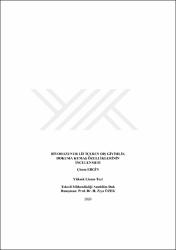| dc.contributor.advisor | Özek, Hikmet Ziya | |
| dc.contributor.author | Ergin, Çisem | |
| dc.date.accessioned | 2022-04-06T06:49:24Z | |
| dc.date.available | 2022-04-06T06:49:24Z | |
| dc.date.issued | 2020 | |
| dc.identifier.uri | https://tez.yok.gov.tr/UlusalTezMerkezi/TezGoster?key=wf-FPgY-5qjHEzEoOgvMs3OYDGjuDWQxRLCoUbhhXvFqW6zxZIHNmTCfvoukIsOk | |
| dc.identifier.uri | https://hdl.handle.net/20.500.11776/4089 | |
| dc.description.abstract | Son yıllarda tekstil üretiminin yol açtığı çevresel etkilerin yanı sıra, sentetik esaslı lif atıklarından kaynaklanan kirlilikler tekstil sektöründe çözüm bekleyen kritik gündem maddeleri arasında yer almıştır. Tekstil endüstrisi kumaş üretim süreçlerinde yaygın, kullanılan lif tipleri ve ortaya çıkan çeşitlilik çevreci ve sürdürülebilir üretim gereklerinden uzaklaşmaktadır. Günümüzde sürdürebilirliğin artan önemiyle, her sektörde olduğu gibi tekstil sektöründe de bu bilinçle üretimlerin yapılması hedeflenmektedir. Biyoplastik kategorisinde yer alan ve çok yönlü kullanımı olan malzeme gruplarından, biyobozunur (biodegradable) ve biyoaktif (bioactive) olan mısır nişastası, pancar kökü veya şeker kamışı gibi yenilenebilir kaynaklardan üretilen termoplastik malzemeler önem kazanmaya başlamıştır. Biyobozunur materyallerin sürdürülebilirlik yaklaşımıyla kullanımı yaygınlaşmaya başlamıştır. Bu malzemeler çok iyi derecede ısıl şekillendirme, yapıştırma ve boyama özellikleri göstermektedir. Kullanım ömrü kısa olan ürünler ya da karbon ayakizi çok büyük olan standart plastiklere göre rekabetçi avantajlar sağlamaktadır. Tekstil sektörünün mekanik ve performans gereksinimlerini nihai uygulamalara uygun olarak karşılayan % 100 biyo bazlı ve biyolojik olarak parçalanabilir bir nihai giyim ürünü elde etmek, kumaş içerisinde biyobozunur materyaller ve diğer tekstil ham maddelerinin farklarını değerlendirmek önemlidir. Biyobozunur lifler üzerine çok çeşitli çalışmalar yapılmış olsa da; bunların moda sektöründe marka firmaların koleksiyon standartlarına uygunluğu üzerine yeterli veri olmadığı görülmüştür. Bu çalışmada biyobozunur elyaflardan endüstriyel standartları karşılayan çevre dostu dokuma kumaş ürünleri geliştirilmesi, üretim ve nihai ürün performanslarının değerlendirilmesi ve bu alanda literatürdeki eksikliklerin giderilmesi amaçlanmıştır. Çalışma kapamında polilaktikasit lifinden üretilmiş kumaş ile bu lifin pamuk, viskon ve tencel lifleri ile karışımlarından oluşan kumailar incelenmiştir. Polilaktik asit liflerini kullanmanın, mekanik performans, haslıklar ve biyobozunurluk açısından gereken kalite krtiterlerin sağlayabildiği görülmüştür. | en_US |
| dc.description.abstract | In addition to the environmental effects caused by textile production in recent years, impurities originating from synthetic fibres have been among the critical agenda items waiting for solutions in the textile industry. In the textile industry fabric production processes, the materials used and the diversity that emerges diverges from sustainability. Today, the importance of sustainability is aimed to produce with this awareness in the textile industry as in every sector. It is a thermoplastic produced from renewable sources such as corn starch, beet root or sugar cane, which are biodegradable and bioactive, which are among the versatile material groups in the bioplastic category. The importance of biodegradable materials increases with the sustainability approach. These materials show very good thermal forming, bonding and painting properties. It provides competitive advantages over products with short lifetimes or standard plastics with a very large carbon footprint. It is important to obtain a 100% bio-based and biodegradable final clothing product that meets the mechanical and performance requirements of the textile industry in accordance with the final applications, and to evaluate the differences in biodegradable materials and other textile raw materials within the fabric. Thera appears several studies on biodegradable fibres but limited data on their applicability into fashion products of the brand owners. In this study, it is aimed to develop eco-friendly woven fabric products from biodegradable fibres to evaluate the performances of production and the final product. The samples of woven fabrics made by poly lactic acid (PLA) fibres and their blends with cotton, viscose and tencell are produced in accordance with the industrial standards and requirements. It is observed that the usage of PLA fibres proves to be sufficient on the bases of mechanical performance, fastness and biodegradability measures. | en_US |
| dc.language.iso | tur | en_US |
| dc.publisher | Tekirdağ Namık Kemal Üniversitesi | en_US |
| dc.rights | info:eu-repo/semantics/openAccess | en_US |
| dc.subject | Tekstil ve Tekstil Mühendisliği | en_US |
| dc.subject | Textile and Textile Engineering | en_US |
| dc.subject | Biyobozunur lif | en_US |
| dc.subject | Sürdürülebilirik | en_US |
| dc.subject | Dokuma Kumaş | en_US |
| dc.subject | Polilaktikasit lifi | en_US |
| dc.subject | Biodegradable fiber | en_US |
| dc.subject | Sustainability | en_US |
| dc.subject | Woven Fabric | en_US |
| dc.subject | Polylactic acid fiber | en_US |
| dc.title | Biyobozunur lif içeren dış giyimlik dokuma kumaş özelliklerinin incelenmesi | en_US |
| dc.title.alternative | A study of properties of woven apparel fabrics containing biodagrable fibers | en_US |
| dc.type | masterThesis | en_US |
| dc.department | Enstitüler, Fen Bilimleri Enstitüsü, Tekstil Mühendisliği Ana Bilim Dalı | en_US |
| dc.identifier.startpage | 1 | en_US |
| dc.identifier.endpage | 106 | en_US |
| dc.institutionauthor | Ergin, Çisem | |
| dc.relation.publicationcategory | Tez | en_US |
| dc.identifier.yoktezid | 650278 | en_US |



















